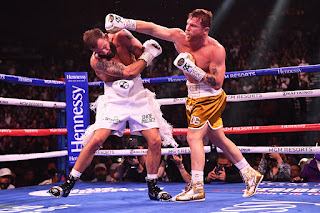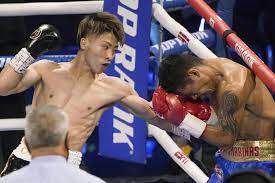It is difficult to become comfortable with boxing. But once you are comfortable, it is very easy to stay comfortable. This is the state where you have learned and understand the basics. You no longer have to think about throwing a hook, you just throw it. Of course it's not perfect but you've got the body mechanics now. You're rotating, able to use your lower body, and stay balanced. And you are what I would consider to be a "comfortable boxer."
Is that a bad thing? Not at all! As I mentioned, it is hard to get to this level. Takes practice, hard work, and the ability to learn. You should be proud of yourself! So what's next?
Usually, this is where I like to challenge people physically a little more. You're throwing good combos, your form is on the right track, so let's make the workout tougher by moving faster, hitting harder, flowing together more smoothly, etc. Only thing is, that might make you uncomfortable again. And you did all this work just to get comfortable! Going back to be potentially being uncomfortable may not sound that enticing. Can't you just savor it? Of course you can! But you want to get better, right? Boxing and/or fitness, right? Then that means you have to leave your comfort zone again but take heart, you have already completed the first step, which again I said was difficult, and you did it! You can take the next step too!!
This conditioning phase is ongoing but you will feel start to feel more and more of a difference as you go. Then comes the harder step. The skills part again. You've worked hard to develop the skills you have, you've taken them to a new level, you're doing great. Once again, you are comfortable although even more so as you've done more work. Adding new skills will be extra tough, harder than conditioning, because you may be doing something you are not familiar with at all and/or doesn't come naturally. So it might be awkward at first. And yes, you will almost definitely feel uncomfortable again. More so!
What could those skills be? For a lot of folks, it involves footwork. I've said before on this very blog that footwork is the most important thing in boxing and it is probably the 2nd hardest to learn. Boxing footwork is not natural at all to anyone for several reasons and being able to execute it quickly and efficiently while throwing and dodging punches is gonna be tricky. Then there's the conditioning part of footwork too. Staying on your toes, moving in an out constantly, taking angle steps, etc. is going to tire you out faster than just standing relatively still or plodding along. So it's a big mental and physical challenge for sure.
But it certainly doesn't have to be footwork at all. Could be any skill. Throwing different punches, different combinations, working different energy systems, changing styles, anything. And as I said at the beginning, it doesn't matter how good you get, you can and should always be willing to add new tricks to your bag. Look at someone like LeBron James in basketball. He's pretty good, right? He was always good too - an all-star caliber player when he came into the league at 18 years old, straight out of high school. But instead of just making himself a better version of him at 18, he has evolved and changed his game to make him something entirely different at 37. He even played an entirely different position and focused on something he had never really focused on before- assists- to help his team win an NBA championship. Michael Jordan did something similar in his career. As have other athletes in other sports and usually the ones who hang around the longest with the most success, are able to constantly evolve.
I've had some more experienced fighters take my classes and seen others honestly, too chicken to even try one out. But that doesn't make sense, does it? How could someone who's trained in boxing for years, be afraid to try a class with potential first-timers? Not because they can't do it. Of course they can. But because they will be uncomfortable.
They've trained for years maybe and will tell themselves that they are simply too good for such a class but the reality is, whether you're brand new or the greatest boxer in the world, you are going to throw jabs, you are going to throw crosses, you are going to throw hooks, you are going to throw combinations and anyone who's ever achieved any high level in any sport, knows that you must practice those things over and over again. But if they come to my class, they might be asked to do something they aren't used to doing. Not because it's crazy and wouldn't make any sense but because it's just not part of their normal repertoire. Everybody has stuff they like doing and practice more than others. Could also be a pacing that they aren't used to. And they might look bad by stepping out of their comfort zone and doing anything unfamiliar in even the smallest way. Or maybe not "bad,” just not as good as they really are. The better you get at boxing, the more you don't want to ever look bad!
Then the boxers that have come in go really slowly, touching up the bag and never really exploding. Maybe it is just how are used to training but you would/should never do that for an entire fight. And I would bet money that it is the same issue. If they work too hard, they might get a little out of control and even that alone feels like looking bad or not performing up to their standards. So they keep it close to the vest and play it safe instead.
I have gone off on a long tangent here but I am doing it to illustrate the point that being uncomfortable is really tough and may just get tougher the better you get at something. And it happens to all of us. It is completely normal. Being comfortable is great! I wouldn't tell anyone that they must be uncomfortable ALL the time to get better either. There are plenty of times to stay comfortable and appreciate the fruits of your labor without stressing about the next step. There are also times where it's time to leave the comfort zone to make some meaningful changes. Those times vary for everyone but if you've been a comfortable boxer for a while, at any stage, the time may be NOW. Instead of telling yourself that it is going to suck to push yourself a little harder mentally and physically and that you may look and feel a little off doing it, instead think of how good it is going to be to getter better. Faster, stronger, healthier, tougher! While you may not look as good at first, you are going to look better later. The reward is far greater than the risk!

















